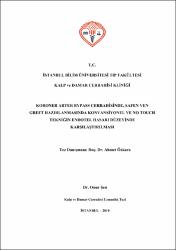| dc.contributor.advisor | Özkara, Ahmet | en_US |
| dc.contributor.author | Şen, Onur | |
| dc.date.accessioned | 2014-06-30T13:04:03Z | |
| dc.date.available | 2014-06-30T13:04:03Z | |
| dc.date.issued | 2010 | |
| dc.date.submitted | 2010 | |
| dc.identifier.citation | Şen, Onur. (2010). Koroner Arter Bypass Cerrahisinde, Safen Ven Greft Hazırlanmasında Konvansiyonel ve No Touch Tekniğin Endotel Hasarı Düzeyinde Karşılaştırılması. Yayımlanmamış doktora tezi. İstanbul : İstanbul Bilim Üniversitesi, Tıp Fakültesi. | en_US |
| dc.identifier.uri | https://hdl.handle.net/11446/231 | en_US |
| dc.description | İstanbul Bilim Üniversitesi, Tıp Fakültesi, Kalp ve Damar Cerrahisi Anabilim Dalı | en_US |
| dc.description.abstract | Bu çalışmada; iskemik kalp hastalığı nedeniyle koroner arter baypas grefti operasyonuna karar verilmiş hastalarda, kullanılacak safen ven greftin hazırlanması sırasında oluşabilecek endotel hasarından korunmak amacıyla, klasik yöntem ile ″no touch″ yöntemini karşılaştırdık.
Çalışmaya her iki cinsten, koroner arter baypas greft operasyonu geçirecek varis ve venöz yetmezlik tanısı almamış sağlıklı vena safena magna (VSM)’ya sahip toplam 40 hasta alındı. Hastalar iki guruba ayrıldı. 20 hastadan no touch (grup a) yöntemiyle; 20 hastadan ise klasik (grup b) yöntemle safen ven hazırlandı. Her iki gruptan safen venin proksimal bölümünden atravmatik müdahale ile örnekler alındı. Örnekler iki parçaya ayrılarak ışık ve elektron mikroskobunda incelenmek üzere uygun yöntemle tespit edilerek hazırlandı. Işık ve elektron mikroskopta örneklerin intima, media ve adventisya bölümleri incelendi. Histomorfolojik olarak klasik yöntemle hazırlanan safen venlerde vasküler yapının bozulduğu, endotel harabiyetinin ileri derecede olduğu gözlendi. No touch grubunda ise vasküler yapının korunduğu, intimadaki endotel hasarının da minimal düzeyde olduğu gözlemlendi. Hücreler hasar yönünden (Grade 1,Grade 2, Grade 3, Grade 4) değerlendirilerek sayıldı.
Gruplar arasında intima bölümünde Grade 2 ve Grade 3 yapıya sahip hücre gözlemlenmedi. Ancak grup a örneklerinin homojen olarak Grade 1, grup b örneklerinin de yine homojen olarak Grade 4 yapıya sahip olduğu görüldü. İstatistiksel olarak gruplar arasında hem Grade 1, hem Grade 4 hücre açısından oldukça anlamlı bir fark olduğu (p<0.001) saptandı ve ven intimasının klasik yöntem ile safen ven hazırlanırken ileri derecede bozulduğu görüldü.
Sonuç olarak histomorfolojik olarak endotel harabiyetinin klasik yöntemle safen ven hazırlanması sırasında daha ciddi düzeyde olduğu; no touch grubunda ise bu harabiyetin daha az olduğu görüldü. Bu anlamlı farkın klinik gidişe ne kadar yansıdığının belirlenmesi için hastalara belirli bir süre sonra koroner anjiyografi yapılması düşünülebilir. | en_US |
| dc.description.abstract | In this work, we studied patients who were diagnosed with ischemik heart disease and were expected to receive a coronary artery bypass graft operation. We compared the classical method and the no-touch method, both of which can be used to prevent endothelial damage during the preparation of the safen vein graft.
Our subjects were 40 patients who were expected to receive a coronary artery bypass operation. These patients were not diagnosed with varis and venous deficiency and they had healthy vena safena magna (VSM). We seperated the patients into two groups; 20 patients had their veins prepared with the no-touch (group a) method and 20 patients had their veins prepared with the classical (group b) method. Samples were taken from both groups using VSM proximal region using the atraumatic procedure. Samples were divided into two and were prepared to be analyzed using light and electrone microscope. Intima, media, and adventitia regions of the samples were analyzed using light and electronie microscope. Safen veins that were prepared using the classical method were observed to have degraded vascular structure and advanced stages of endothelial degradation. Veins that were prepared using the no-touch method were observed to have preserved their vascular structure and had minimal endothelial damage. Cell damage was categorized using the classification (grade 1, grade 2, grade 3, grade 4).
Neither group's intima section had grade 2 or grade 3 cells. However, group a samples were homogenously grade 1 and group b's samples were homogenously grade 4. Statistically, there was a significant (p<0.001) difference between the groups in terms of grade 1 and grade 4 cells and vein intima was observed to degrade radically when the safen vein was prepared with the classical method.
In conclusion, we observed that histomorphologic endothelium damage was significant when safen veins were prepared with the classical method, whereas preparing with the no-touch method led to less damage. In order to study the effects of this study to clinical work, one could conduct coronary angiography to patients in the future. | en_US |
| dc.language.iso | tur | en_US |
| dc.publisher | İstanbul Bilim Üniversitesi, Tıp Fakültesi. | en_US |
| dc.rights | info:eu-repo/semantics/openAccess | en_US |
| dc.subject | safen ven grefti | en_US |
| dc.subject | mekanik distansiyon | en_US |
| dc.subject | endotel hasarı | en_US |
| dc.subject | koroner arter baypas grefti | en_US |
| dc.subject | safen vein graft | en_US |
| dc.subject | mechanical distension | en_US |
| dc.subject | endotelial damage | en_US |
| dc.subject | coronary artery bypass graft | en_US |
| dc.title | Koroner arter bypass cerrahisinde, safen ven greft hazırlanmasında konvansiyonel ve no touch tekniğin endotel hasarı düzeyinde karşılaştırılması | en_US |
| dc.title.alternative | Comparison of convantional and no-touch technique in harvesting saphenous vein for coronary artery by-pass grafting in the view of endothelial damage | en_US |
| dc.type | doctoralThesis | en_US |
| dc.department | DBÜ, Tıp Fakültesi | en_US |
| dc.contributor.authorID | TR140957 | en_US |
| dc.relation.publicationcategory | Tez | en_US |


















